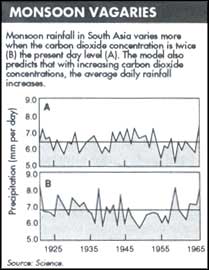In the grip of carbon dioxide
In the grip of carbon dioxide

WHY IS the Indian monsoon so capricious as to cause floods one year and pass on with scarcely any rain the next? Blame it on the increasing concentration of atmospheric carbon dioxide, say US scientists who have constructed a global climate model that predicts an even more whimsical monsoon when carbon dioxide reaches twice its present level.
The model, for the first time, attempts to predict how an increase in atmospheric carbon dioxide will affect the intensity of the south Asian monsoon. Gerald A Meehl and Warren M Washington of the National Center for Atmosphere Research in Boulder, USA, simulated the results of the data from 1921 to 1965 for two sets of carbon dioxide values: one leading to present-day or actual concentrations and another (hypothetical) leading to twice that. To their credit, in the first case, the model generated almost the same range of variability for the 45-year period as the actual monsoon.
The model allowed the scientists to identify factors that may make the south Asian monsoon more flighty in a future carbon dioxide-enriched climate. One of these was the greater warming of ocean surfaces owing to increased CO2 concentration: An anomalously warm sea in the tropical Pacific with doubled carbon dioxide will lead to a weaker south Asian monsoon.
Meehl and Washington compared the performance of their model with observed anomalies in the temperatures of both land and ocean, along with the behaviour of the Indian monsoon during two post-1950 20-year periods. These data showed that both the south Asian monsoon land area and the Indian Ocean were warmer between 1971 and 1990 than between 1946 and 1965. Consistent with this decrease in the land-sea temperature contrast, monsoon rainfall over India was less between 1971 and 1990 than between 1946 and 1965.







